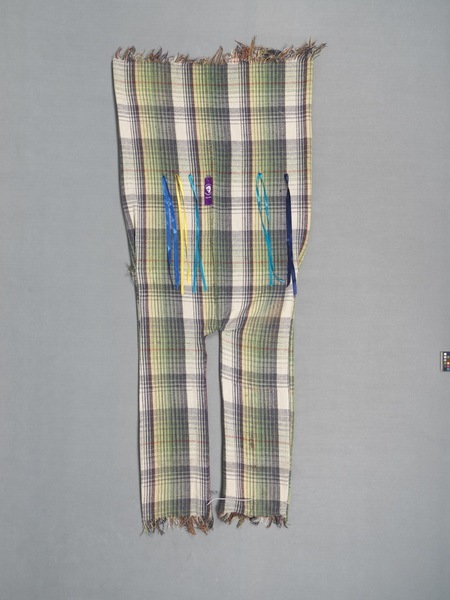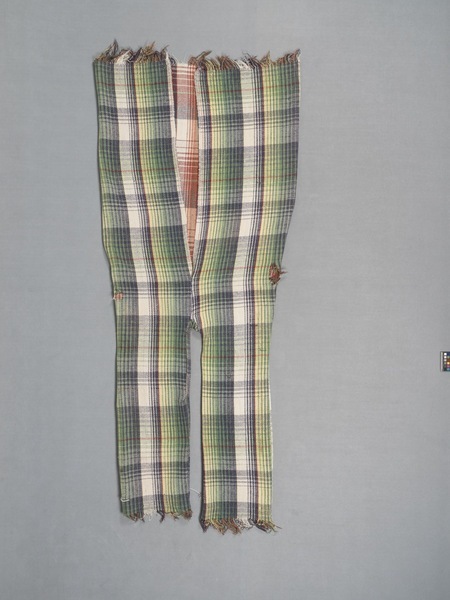Devil Costume Item Number: 3289/2 from the MOA: University of British Columbia


Description
Green, navy, yellow and cream plaid wool devil costume with ribbons attached. Full-body costume, with bottom section sewn into long pant legs, and an open top. Short fringe on pant cuffs and along top of garment. Five long ribbons are safety-pinned to the front - royal blue, yellow, light blue and navy, and one small ribbon, which reads 'Jesus Nazareno Abril 2006' with an image of Jesus. The back of the top portion of the garment is not sewn down the centre. The left pant cuff has a white synthetic rope drawn through the weave.
History Of Use
Costumes such as these, along with masks, are worn during “Easter Battles” that take place in front of the main church in San Bartolomé Aguas Caliente, in the Apaseo el Alto Municipality. Because the Spanish missionaries forced the association of pre-Columbian deities with the the Devil, it is possible that the native peoples of Mesoamerica sympathised with the Devil. Lucifer’s rebellion and ejection from hell may have struck a chord with the people’s own vilification and re-sultant uprisings. At Easter in San Bartolomé the central plaza becomes a battlefield between hundreds of masked, costumed devils and the un-masked, purple t-shirted followers of Christ. The Devils are called 'cornudos' (horned ones). Filling the battlefield, both factions move back and forward, fighting in pairs and using steel-bladed machetes. No side seems to win. The masked cornudos stay for a few days until Christ is resurrected; then they disappear for another year. The costume would be worn with the upper edge caught in the band of the mask at the back of the neck, with the sides hanging down over the shoulders.
Narrative
In 2017 Guanajuato was one of the Mexican states most affected by drug-related crime. Authorities from the Apaseo municipality were made uncomfortable by inquiries concerning this context. Shortly before this mask was collected, there was a large unexplained explosion in Apaseo, which locals attributed to organised crime units.
Cultural Context
festivals; carnival
Item History
- Made by Dalio Angel Perrusquia (Maker) in San Bartolo, Guanajuato, Mexico during 2015
- Collected by Laura Osorio between 2017 and 2018
- Owned by Laura Osorio before April 11, 2018
- Received from Laura Osorio (Seller), Museum of Anthropology Exhibitions Budget (Funding source) and Michael O'Brian Family Foundation (Funding source) on April 11, 2018
What
- Name
- Devil Costume
- Identification Number
- 3289/2
- Type of Item
- costume
- Material
- wool fibre, fibre and metal
- Overall
- height 255.0 cm, width 81.5 cm
Who
- Culture
- Mexican
- Creator
- Dalio Angel Perrusquia (Maker)
- Field Collector
- Laura Osorio
- Previous Owner
- Laura Osorio
- Received from
- Laura Osorio (Seller), Museum of Anthropology Exhibitions Budget (Funding source) and Michael O'Brian Family Foundation (Funding source)
Where
- Holding Institution
- MOA: University of British Columbia
- Made in
- San Bartolo, Guanajuato, Mexico
When
- Creation Date
- during 2015
- Collection Date
- between 2017 and 2018
- Ownership Date
- before April 11, 2018
- Acquisition Date
- on April 11, 2018
Other
- Item Classes
- textiles
- Condition
- good
- Accession Number
- 3289/0002